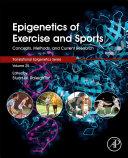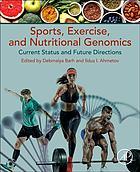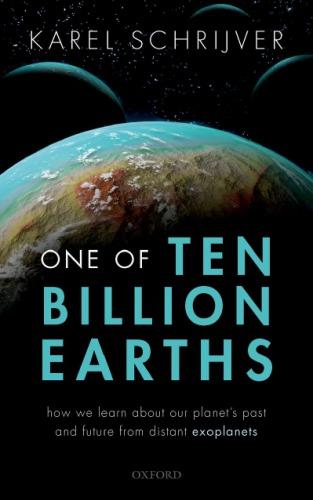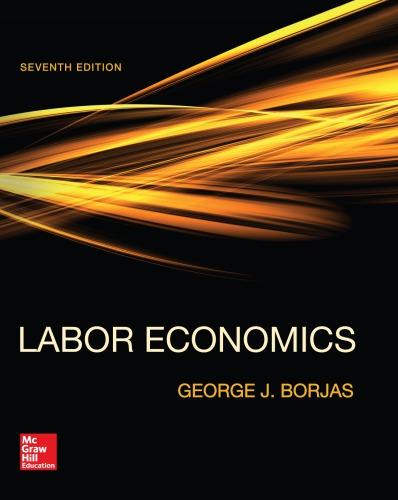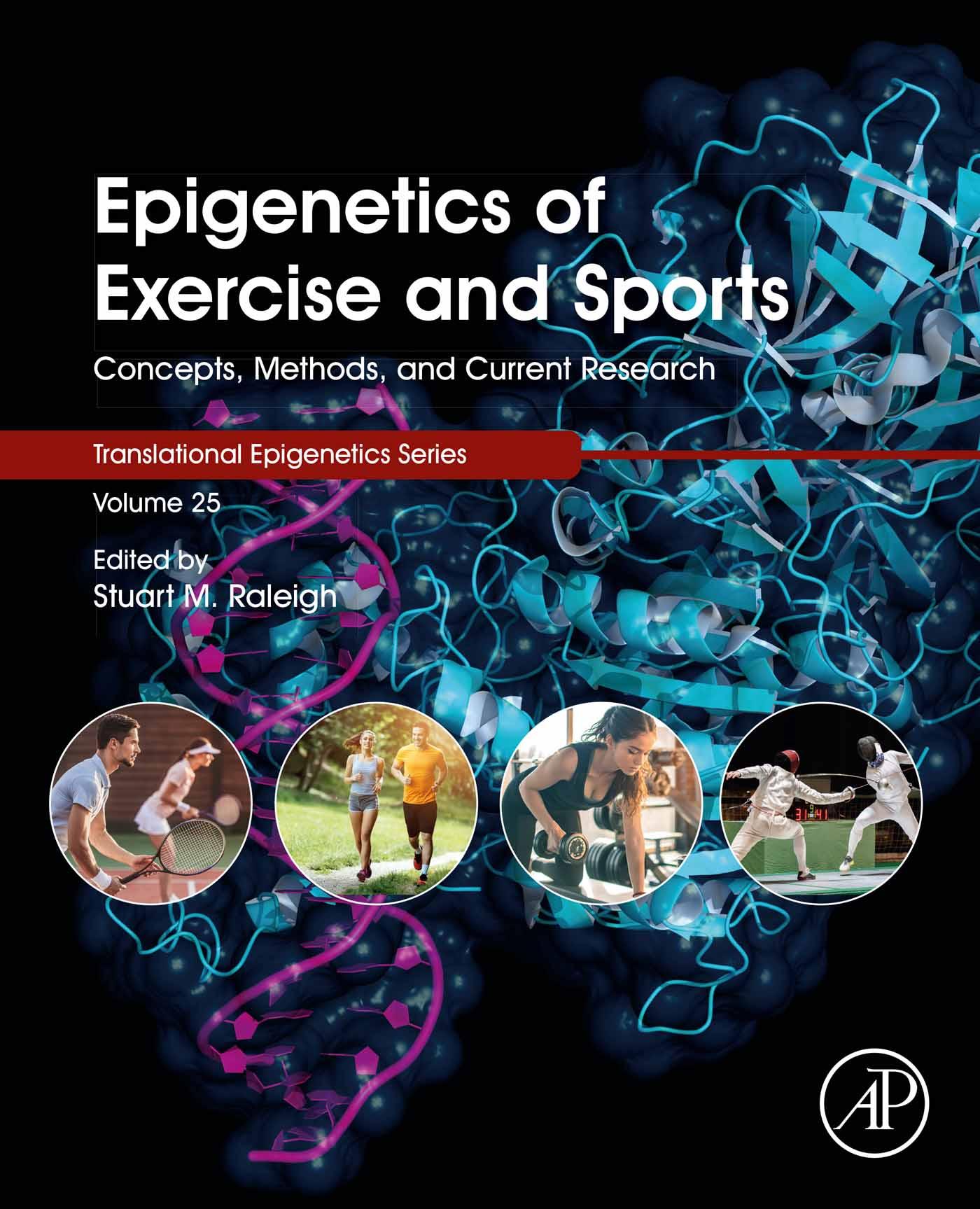Table of Contents
Cover image
Title page
Copyright
Contributors
Preface
A note on how to use this book
Section I: Concepts and methods
Chapter 1: Exercise and sport: Definitions, classifications, and relevance to population health
Abstract
Introduction
Defining physical activity and population categories
What are the physical activity guidelines, and are we meeting them?
Physiological implications of physical activity and inactivity
Exercise intensity domains
Exercise at the extremes
Individual responses to diet and exercise
Chapter 2: Epigenetic processes An overview
Abstract
Introduction
DNA methylation
CpG islands
DNA methylation and gene imprinting
Histone modification
Noncoding RNAs
Epigenetic-based therapies
RNA methylation
Epigenetic interactions, networks, and emergent properties
Conclusions
Chapter 3: Methods to study exercise and sports epigenetics
Abstract
Acknowledgement
Introduction
Ethical considerations and sample collections
DNA methylation
Chip-Seq
Noncoding RNAs
Conclusion
Section II: Current research and future perspectives
Chapter 4: Nutrients, metabolism, and epigenetic change
Abstract
Diet and nutri-epigenomics
What is DNA methylation?
Fatty acids and epigenetics
Conclusion
Chapter 5: Obesity epigenetics and exercise
Abstract
Introduction
Role of epigenetics in syndromic and monogenic obesity
Maternal and paternal impact on obesity predisposition in their children and beyond
Can epigenetic-mediated obesity predisposition change during adulthood?
Could epigenetic treatments help tackle the obesity pandemic?
Final conclusions
Chapter 6: Epigenetic change and different types of exercise
Abstract
Exercise
Epigenetic modifications
Exercise-induced DNA methylation
Exercise-induced histone modifications
Exercise-induced noncoding RNAs
Conclusion
Chapter 7: Exercise, epigenetics, and aging
Abstract
Introduction
Aging defined
Benefits of physical activity
Aging and epigenetics
Exercise and the epigenetic response
Exercise and DNA methylation
Exercise and histone modifications
Exercise and MicroRNA
Exercise, epigenetics, and cancer
Exercise, epigenetics, and inflammation
Exercise epigenetics and cardiovascular diseases
Exercise, epigenetics, and neurological disorders
Exercise, metabolism, and epigenetics
Telomere biology
Telomerase
Mean leukocyte telomere length
Aging-telomere link
Telomeres, aging, and mortality
Telomeres and senescence
Telomeres and age-related diseases
Physical activity and telomere length
Proposed benefits of physical activity on telomere homeostasis
Oxidative stress
Inflammation
The Shelterin complex
Epigenetics and telomere homeostasis
Epigenome, exercise training, and trans-generational inheritance
Summary
Chapter 8: Epigenetics, exercise, and the immune system
Abstract
Acknowledgments
Introduction to epigenetics
Overview of immunity and exercise
Immune system epigenetic modifications via physical activity and exercise
MicroRNA regulation of immune cells in aerobic exercise
Exercise as a putative modifier of cancer pathogenesis
Conclusions
Chapter 9: Alzheimer’s disease, epigenetics, and exercise
Abstract
Alzheimer’s disease
Exercise and memory
Cellular and molecular mechanisms of exercise-induced neurogenesis
Genetic considerations
Transgenerational effects
Conclusions
Chapter 10: The current and future state of sports genomics
Abstract
Introduction
Overview of sports genomics
Candidate gene studies
Genome-wide association studies and next-generation sequencing
Consortia studies
Limitations and future directions
Conclusion
Chapter 11: Epigenetic regulation and musculoskeletal injuries
Abstract
Introduction
Epigenetic risk factors underlying musculoskeletal injuries
Clinical implications of epigenetic testing for musculoskeletal soft tissue injuries
Concluding remarks
Chapter 12: Sports concussion and epigenetics
Abstract
Introduction
Definition of concussion
Diagnosis of concussion
Short-term consequences of concussion
Long-term consequences of concussion
Genetics of concussion
Epigenetics
Epigenetics of TBI
Epigenetics of concussion
Epigenetic pattern profiling as a biomarker to aid concussion diagnosis
Epigenetic pattern profiling as a biomarker for short-term outcomes following concussion
Conclusions and future directions
Chapter 13: Epigenetics and doping in sports The role of microRNAs
Abstract
Acknowledgments
Introduction
Novel epigenetic markers: miRNAs
MicroRNAs for detection of doping abuse
MicroRNAs as potential markers of autologous blood transfusion in sports
Confounding factors
Conclusions and perspectives
Chapter 14: Future perspectives and concluding remarks
Abstract
Introduction
Future avenues for research
Closing remarks
Index
Copyright
Academic Press is an imprint of Elsevier
125 London Wall, London EC2Y 5AS, United Kingdom
525 B Street, Suite 1650, San Diego, CA 92101, United States
50 Hampshire Street, 5th Floor, Cambridge, MA 02139, United States
The Boulevard, Langford Lane, Kidlington, Oxford OX5 1GB, United Kingdom
Copyright © 2021 Elsevier Inc. All rights reserved.
No part of this publication may be reproduced or transmi�ed in any form or by any means, electronic or mechanical, including photocopying, recording, or any information storage and retrieval system, without permission in writing from the publisher. Details on how to seek permission, further information about the Publisher’s permissions policies and our arrangements with organizations such as the Copyright Clearance Center and the Copyright Licensing Agency, can be found at our website: www.elsevier.com/permissions.
This book and the individual contributions contained in it are protected under copyright by the Publisher (other than as may be noted herein).
Notices
Knowledge and best practice in this field are constantly changing. As new research and experience broaden our understanding, changes in research methods, professional practices, or medical treatment may become necessary.
Practitioners and researchers must always rely on their own experience and knowledge in evaluating and using any information, methods, compounds, or experiments described herein. In using such information or methods they should be mindful of their own safety and the safety of others, including parties for whom they have a professional responsibility.
To the fullest extent of the law, neither the Publisher nor the authors, contributors, or editors, assume any liability for any injury and/or damage to persons or property as a ma�er of products liability, negligence or otherwise, or from any use or operation of any methods, products, instructions, or ideas contained in the material herein.
Library of Congress Cataloging-in-Publication Data
A catalog record for this book is available from the Library of Congress
British Library Cataloguing-in-Publication Data
A catalogue record for this book is available from the British Library ISBN 978-0-12-820682-9
For information on all Academic Press publications visit our website at h�ps://www.elsevier.com/books-and-journals
Publisher: Andre Gerhard Wolff
Acquisitions Editor: Peter B. Linsley
Editorial Project Manager: Megan Ashdown
Production Project Manager: Maria Bernard
Cover Designer: Miles Hitchen
Typeset by SPi Global, India
Contributors
Olutope Arinola Akinnibosun School of Science, Psychology, and Sport, Federation University Australia, Ballarat, VIC, Australia
Mark Antrobus Centre for Physical Activity and Life Sciences, University of Northampton, Northampton, United Kingdom
Fadi J. Charchar Health Innovation and Transformation Centre and School of Science, Psychology, and Sport, Federation University Australia, Ballarat, VIC, Australia
Warrick Chilton School of Science, Psychology, and Sport, Federation University Australia, Ballarat, VIC, Australia
Tom Cullen Sport and Human Performance Research Group, Centre for Sport, Exercise and Life Sciences, Coventry University, Coventry, United Kingdom
Saul Cu�ell Centre for Physical Activity and Life Sciences, University of Northampton, Northampton, United Kingdom
Louis Y. El Khoury
Department of Molecular Pharmacology and Experimental Therapeutics
Center for Individualized Medicine, Epigenomics Program, Mayo Clinic, Rochester, MN, United States
Alessia Fino�i Department of Life Sciences and Biotechnologies, Section of Biochemistry and Molecular Biology, University of Ferrara, Ferrara, Italy
Steven S. Foster School of Life Sciences, Faculty of Health and Life Sciences, Coventry University, Coventry, United Kingdom
Roberto Gambari Department of Life Sciences and Biotechnologies, Section of Biochemistry and Molecular Biology, University of Ferrara, Ferrara, Italy
Jessica Gasparello Department of Life Sciences and Biotechnologies, Section of Biochemistry and Molecular Biology, University of Ferrara, Ferrara, Italy
D.J. Hunter School of Sport, Exercise and Health Sciences, Loughborough University, Loughborough, United Kingdom
B. Hussey School of Sport, Exercise and Health Sciences, Loughborough University, Loughborough, United Kingdom
L. James School of Sport, Exercise and Health Sciences, Loughborough University, Loughborough, United Kingdom
Mary-Jessica N. Lague�e
Division of Exercise Science and Sports Medicine, Department of Human Biology, Faculty of Health Sciences, University of Cape Town
International Federation of Sports Medicine (FIMS) Collaborative Centre of Sports Medicine
UCT Research Centre for Health through Physical Activity, Lifestyle and Sport (HPALS), Cape Town, South Africa
Nicola Lamberti Department of Neuroscience and Rehabilitation, Section of Sport Sciences, University of Ferrara, Ferrara, Italy
M.R. Lindley School of Sport, Exercise and Health Sciences, Loughborough University, Loughborough, United Kingdom
Lee R. Machado Centre for Physical Activity and Life Sciences, University of Northampton, Northampton, United Kingdom
Michelle C. Maier School of Science, Psychology, and Sport, Federation University Australia, Ballarat, VIC, Australia
Fabio Manfredini Department of Neuroscience and Rehabilitation, Section of Sport Sciences, University of Ferrara, Ferrara, Italy
S.S. Mastana School of Sport, Exercise and Health Sciences, Loughborough University, Loughborough, United Kingdom
Sarah Mc Fie Department of Psychology, Faculty of Humanities, University of Cape Town, Cape Town, Western Cape, South Africa
Brendan J. O’Brien School of Science, Psychology, and Sport, Federation University Australia, Ballarat, VIC, Australia
Michael Posthumus
Sports Science Institute of South Africa, University of Cape Town, Cape Town, Western Cape
Division of Exercise Science and Sports Medicine, Department of Human Biology, Faculty of Health Sciences, University of Cape Town; International Federation of Sports Medicine (FIMS)
Collaborative Centre of Sports Medicine, Cape Town, South Africa
Stuart M. Raleigh Cardiovascular and Lifestyle Medicine Research Group, Coventry University, Coventry, United Kingdom
Stephen M. Roth Department of Kinesiology, School of Public Health, University of Maryland, College Park, MD, United States
Alison V. September
Division of Exercise Science and Sports Medicine, Department of Human Biology, Faculty of Health Sciences, University of Cape Town
International Federation of Sports Medicine (FIMS) Collaborative Centre of Sports Medicine
UCT Research Centre for Health through Physical Activity, Lifestyle and Sport (HPALS), Cape Town, South Africa
Mathijs A.M. Suijkerbuijk Department of Orthopaedic Surgery, Erasmus MC, University Medical Center Ro�erdam, Ro�erdam, The Netherlands
Nicholas B. Tiller Institute of Respiratory Medicine and Exercise Physiology, The Lundquist Institute for Biomedical Innovation at Harbor-UCLA Medical Center, Torrance, CA, United States
Preface
Stuart M. Raleigh, Cardiovascular and Lifestyle Medicine Research Group, Coventry University, Coventry, United Kingdom
My career as a scientist started back in the 90s. At that time I and my colleagues often used to use the term epigenetics to refer to environmental factors that in some way altered the expression of genes and therefore modified a phenotype. Although this concept was correct, we had very li�le knowledge or understanding of how these processes occurred. It was not until some years later that the processes of DNA methylation, histone modification, regulation of genes by small (and long) noncoding RNAs became more familiar to me. Since then, our understanding of epigenetic processes has advanced significantly and provided fertile ground for researchers to try and explain how the message encoded within our genomes can be fine-tuned to modify our behavior and risk of disease. Within the fields of exercise science and sports medicine, researchers have, in general, been less focused on epigenetics. There still appears to be a large number of academic papers published that simply ignore this important facet of molecular biology and the assumption seems to be that a certain level of exercise or physical activity affects us all in the same way. Indeed, the concept of personalized exercise is largely absent. This is surprising to me as I feel that epigenetic mechanisms are able to explain (in large part) a variety of traits that are related to exercise including: variability in training response, predisposition to sports injury, motivation and behavior, effectiveness of performance diets, muscle mass alterations during training, range of motion and flexibility as we age and ultimately degree of exercise or sports achievement.
I was thrilled when Elsevier approached me to edit and contribute to this first edition of Epigenetics of Exercise and Sports. I feel the book is timely and I hope it will encourage others working within the fields of exercise and sports research to look at how epigenetic processes might help to explain their data. The book will start with and overview of how physical activity and sports benefits populations along with an explanation of what epigenetics actually is. We then journey through a broad spectrum of topics to show just how dependent exercise response is on epigenetics processes. We also study the limitations associated with the field of exercise genetics and cover ways in which epigenetics might be used to reduce the adverse effects of sports associated pathology.
Ultimately, it is hoped that by understanding the interaction between exercise, sports, and epigenetics we can, in the near future, customize exercise and sports to the individual, improve the management of sports related pathologies and produce more engaged and physically active populations.

